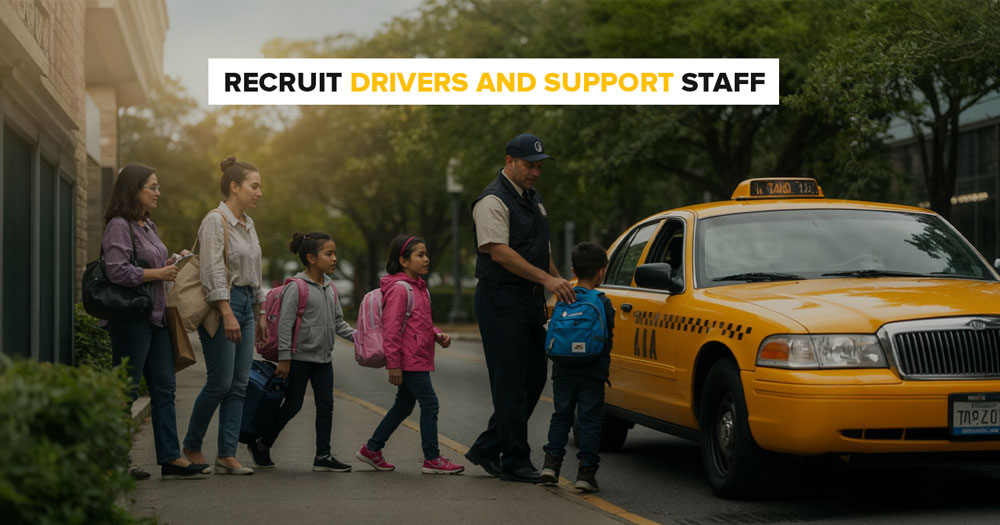This places great demand for dedicated transport providers in the UK. The process of establishing a school transport business is not so hard if you add a touch of planning and adhere to safety regulations in your operations.
- 1. Plan Your Service
- 2. Study the Market
- 3. Select Suitable Vehicles
- 4. Recruit Drivers and Support Staff
- 5. Set Up Pricing and Packages
- 6. Licensing and Registrations
- 7. Insurance and Safety Obligations
- 8. Background Checks and Training
- 9. Contracts and Payments
- 10. Daily Operations and Best Practices
- 11. Use of Technology
- 12. Scaling the Business
- Conclusion
- FAQs
1. Plan Your Service
The initial process in how to start a school transport business is the formulation of a proper service plan. Determine the services you will provide, the ages you will attend and the number of vehicles to acquire.
Your operating hours, pick-up and drop-off points and daily routes should also be included in a good business plan. Parents will be attracted to consistency so make sure it is a realistic and reliable set of schedules.
Consider your pricing model ahead of time whether you will charge on a monthly subscription basis or pay-per trip or contracts with schools. You should make your calculations include fuel, wages, maintenance and insurance coverage so that your service can still be profitable.
Besides allowing you to develop confidence when approaching schools or parents to sign contracts, a detailed service plan can help you set the expectations.
Related Article: 5 Signs Your Taxi Business Needs a Taxi Dispatch Software
2. Study the Market
When planning to invest in vehicles or employment of staff, do not risk any cash paid till you get research into the market. Parents and schools require special needs outside transport. They are looking forward to safety, on time to pick up and credible drivers.
Find out the current providers in your area and what they quote and provide. Identify needs, such as parents having a problem after-school pick up or children with special needs who have no service available to them.
Quite knowledge of these gaps will assist you in carving your services. The competitor’s research can also tell you how to charge and what additional value you can provide, e.g. live tracking or having someone on call to assist passengers.
The more you understand your market, the more easily you are able to develop a service that is distinct.
Related Article: How AI Can Change the Taxi Industry – Transforming Transportation
3. Select Suitable Vehicles
The most important thing is to select the right vehicles in your school transport business. The size and type of vehicles you have must be proportional to the number of students you transport. Minibuses are a favorite since they can easily cater to more passengers and still be affordable whereas smaller vans might be more suitable for certain routes or even kids with special needs.
Your priority should be safety, and this means that all cars must possess seat belts, child locks, first aid boxes, and the cars should be under proper maintenance. The issue of comfort also counts since parents will not want to watch their children ride on a dirty and faulty vehicle.
Other operators paint with logos or school names to develop confidence and recognition. Be sure to confirm local legislation to ensure that your vehicles comply with regulations and uphold minimum requirements that make them safety and licensing compliant.
Related Article: Top 10 Best Taxi Dispatch Softwares In 2025
4. Recruit Drivers and Support Staff

Your drivers and passenger assistants are the foundation of your service. Parents leave the care of their children in their hands and, therefore, you will be required to employ qualified and responsible employees. Screen those drivers who have no or minimal records, have proper licenses, and who have experience in passenger transportation.
A passenger assistant is an additional measure of safety to younger children or those with special educational needs. These aids assist when boarding, carrying the luggage and children during the journey. Training in first aid, safeguarding and disability awareness will result in staff having the ability to manage various situations and create trust.
You will also be able to maintain quality staff with good salaries, understandable schedules and benefits. A reliable collective will not only maintain your service secure but will advance your reputation in the neighborhood as well.
Related Article: How to Improve Fleet Management: Must-Know Tips
5. Set Up Pricing and Packages
A good idea would be to plan the number of times you would be able to charge a lot because of fuel costs, costs of vehicle maintenance and upkeep of the vehicle, driver wages, and insurance your business needs to consider. There are many operators that prefer to offer fixed contracts (per school term), while others offer monthly subscriptions.
The discounts of sibling or group booking will make your service affordable to a family. It is also possible to design flexible packages, e.g. after school activity pick up or weekends when school activity transportation is required. Ensure transparency of your fees You can easily lose trust due to hidden charges
Clear invoices and receipts also help in the development of long relationships with parents. And having a well-designed pricing scheme, you find the balance between profitability and affordability and create a sustainable service.
6. Licensing and Registrations
School transport is an operation that requires proper licensing. Depending on your fleet size and the type of journeys you make, you may require a special operator license, in case you operate minibuses or bigger vehicles. In the case of taxis and smaller vehicles, a private hire license or taxi license with your local council will be required.
Based on these licenses, you are assured that your service is safe and legal. When you apply, you will be required to provide evidence upon vehicle safety tests, entrustment of drivers and insurance. You can have high fines and lose your contract with schools or councils without proper licensing.
It is always advisable to verify with your local authority regarding the licenses to be obtained in relation to the service you offer as this may be different according to the location.
7. Insurance and Safety Obligations
Insurance is an aspect that cannot be negotiated in starting a school transport business. The cover you will require will be public liability insurance in case of harm to passengers, employer liability insurance for the case of your employing staff and motor insurance which is insurance per vehicle.
Cover should be comprehensive as even minor accidents can prove to be very expensive. Councils will not contract services without evidence of valid insurance. Other than insurance, other requirements as far as safety is concerned are ensuring the vehicles are frequently serviced, fitting seatbelts, and first aid kits.
Not only will the children be safe but also by meeting these requirements, it will send a message to the parents and schools that they can place trust in your service.
8. Background Checks and Training
All the drivers and passenger assistants would be required to be checked through a better DBS option to verify that they are safe in working with children. These are essential anywhere and in most cases are a requirement of school transport contacts.
The staff, furthermore, must undergo training in disability focus, first aid, safeguarding as well as handling wheelchairs should they require it. Most of the councils also demand refresher training after several years. Identify authorized staff easily by wearing ID badges and wearing uniforms.
Checks and proper training reveal that your staff is professional, reliable and can undertake the duties of transporting children safely as far as possible.
9. Contracts and Payments
Contracts set out expectations when you are dealing with councils or schools. These normally incorporate terms concerning timeliness, safety and employee behavior. Operators should also abide by the code of practice in transporting customers as advanced by the council.
Councils are likely to make payments on the basis of monthly invoicing and may insist on signed journey records, with invoices, to confirm that the trips have been made. Clear paperwork safeguards you, and the council, to ensure you are being paid exactly right and on time.
To the parents, it is important to offer them readable receipts and invoices to encourage trust. A professional school transport service involves having a payment system and contracts that are transparent.
10. Daily Operations and Best Practices
With a business of transporting students to school, it is important that running the business on a daily basis runs smoothly. Tightly schedule the routes to reduce travel time and fuel expenses. Most operators utilize a GPS tracking system so they can know exactly where their vehicle is located, and so parents have peace of mind.
Morning and afternoons with school runs are hectic and therefore punctuality and consistency should be your main concern. Communicate with schools and parents as to any delays and changes. All the checks of the vehicle, briefings to the drivers and proper communication ensure a smooth ride.
Consistent daily planning will not only keep you safe, but it will also make you highly reputable, resulting in increased referrals and long-term contracts.
11. Use of Technology
Technology can bring tremendous changes to the way you do things. Fleet management software assists you to keep track of routes, drivers and vehicles on a single platform. Using mobile apps and booking systems, parents can easily reserve seats, follow rides and pay.
GPS tracking enhances not only safety but also installs confidence among parents that would like to know where their children are. Within some systems, dispatching, invoicing, and compliance records are automatically filled in, so time is saved on paperwork.
Little money can be spent on technology, which in turn could help you to reduce costs, enhance efficiency, and make your service more attractive to schools and parents. Embracing technology will make you competitive in the expanding market.
12. Scaling the Business
After setting up your transport service to school, you may consider expanding. Most operators diversify into social care transport, with contracts to take passengers who are elderly or disabled on behalf of a council. Some will provide corporate shuttle services or affiliation with catholic schools and activity canters.
You can also include bigger vehicles or larger vehicles such as minibuses. Be focused on safety, compliance, and customer service as you grow. Growth; this should be gradual and strategic, and this way, you have adequate drivers, vehicles and insurance coverage to tackle the extra demand. Being a wise scaler enables you to develop a sustainable business that is multifaceted.
Conclusion
It is a business venture and at the same time a form of service to the people to start a school transport service. The question on how to start a school transport business has the answer in smart planning and strict compliance.
Become a highly qualified network with an efficient service plan, quality vehicles, employee training and reasonable prices. Then, be licensed, insured, have background checks and council contracts.
Lastly, concentrate on seamless day-to-day performance, embrace the use of technology, and consider expansion. Your school transport business can be safe, trusted, profitable and supportive to families and schools in your community with the right approach.




